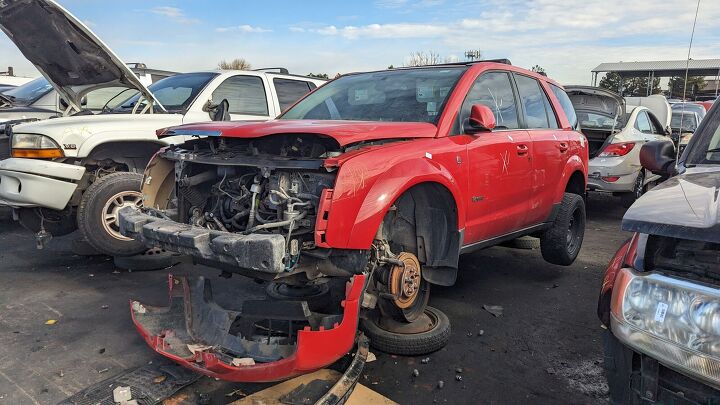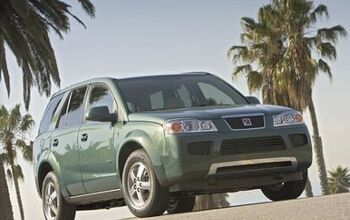Junkyard Find: 2007 Saturn Vue Green Line

Honda beat everybody to the production gasoline-electric hybrid game in the United States, putting the Insight in showrooms in 1999. Toyota followed with the Prius a year later, but it took GM until 2006 to introduce its first true gasoline-electric hybrid here. That car was the 2007 Saturn Vue Green Line, and I managed to find one in a Denver-area car graveyard recently.
Our nameless reviewer felt, back in 2006, that the Vue's panel gaps made it the "automotive equivalent of a shotgun shack" and calculated that the Green Line version would require 90,000 miles of driving with $2.15/gallon gas in order to recoup its cost over the pure-gazzoline version. In fact, fuel prices went insane right around the time that review was written.
If we look at the fine print, GM actually introduced a sort-of-a-hybrid vehicle as a 2004 model, though the 2004 Chevrolet Silverado Hybrid/GMC Sierra Hybrid didn't have regenerative braking.
Ford launched the Escape Hybrid as a 2005 model (its Mercury Mariner and Mazda Tribute siblings showed up a bit later), so The General had some catching up to do in the green-car department. Nissan introduced the Altima Hybrid as a 2007 model (and using licensed Toyota hardware), though it disappeared quickly and without leaving much trace.
Toyota and Honda didn't have much to fear from the Vue Green Line's hybrid technology, but it did benefit from regenerative braking and delivered a pretty good 23 city/29 highway miles per gallon (versus 19/25 mpg for the base Vue with 2.2-liter engine and automatic).
The system replaced the starter motor and alternator with a belt-driven motor/generator rig that generated five horsepower and 48 pound-feet. A 2.4-liter Ecotec gas-burner did most of the work with its 170 horsepower.
You could get a manual transmission in the regular Vue, but the Green Line was slushbox-only.
The green paint has faded from this Green Line badge, but it was supposed to be the Gaia-loving counterpart to the planet-ravaging Saturn Ion Red Line. I have mounted Red Line and Green Line badges side-by-side on my garage wall, in order to represent the duality of man.
The storm clouds over General Motors were getting darker by the minute when this car was built, and Saturn would soon have its head on the chopping block. Geo and Oldsmobile were already gone, with Pontiac and Saturn following in 2010.
The entry-level '07 Vue started at $17,995 (about $27,588 in 2024 dollars), while the Green Line version had an MSRP of $22,995 ($35,254 after inflation). Even with $4/gallon gas ($6.13 gallon in today's money), it would have taken quite a while to break even with the Green Line.
The Vue's platform outlived Saturn and still lives today, though. You'll find its derivatives underpinning everything from the Suzuki XL7 to the Wuling Almaz, and it all began with the 2002 Vue.
The interior isn't bad, but a 17-year-old non-AWD car made by a long-defunct brand doesn't command much resale value these days.
There is a way to recapture the world's imagination. To stay the same in one way, and evolve in another. Chapter 11 bankruptcy was approaching quickly, by the way.
A 2007 Saturn Vue Green Line hybrid in a Colorado wrecking yard.
A 2007 Saturn Vue Green Line hybrid in a Colorado wrecking yard.
A 2007 Saturn Vue Green Line hybrid in a Colorado wrecking yard.
A 2007 Saturn Vue Green Line hybrid in a Colorado wrecking yard.
A 2007 Saturn Vue Green Line hybrid in a Colorado wrecking yard.
A 2007 Saturn Vue Green Line hybrid in a Colorado wrecking yard.
A 2007 Saturn Vue Green Line hybrid in a Colorado wrecking yard.
A 2007 Saturn Vue Green Line hybrid in a Colorado wrecking yard.
A 2007 Saturn Vue Green Line hybrid in a Colorado wrecking yard.
[Images: The Author]
Become a TTAC insider. Get the latest news, features, TTAC takes, and everything else that gets to the truth about cars first by subscribing to our newsletter.

Murilee Martin is the pen name of Phil Greden, a writer who has lived in Minnesota, California, Georgia and (now) Colorado. He has toiled at copywriting, technical writing, junkmail writing, fiction writing and now automotive writing. He has owned many terrible vehicles and some good ones. He spends a great deal of time in self-service junkyards. These days, he writes for publications including Autoweek, Autoblog, Hagerty, The Truth About Cars and Capital One.
More by Murilee Martin
Latest Car Reviews
Read moreLatest Product Reviews
Read moreRecent Comments
- Mikey My youngest girl ( now 48 ) dated a guy that had a Beretta with a stick shift. The Dude liked Beer and weed. too much for my liking..I borrowed my buddy's stick shift Chevette and give her short course on driving a manual .. I told her if the new BF has more than 2 beer or any weed ..You drive ...I don't care how many times you stall it, or or of you smoke the clutch . She caught on quite well ,and owned a succession of stick shift vehicles...An as an added bonus she dumped the guy.
- Blueice "Due to regulation/govt backing, China is poised to dominate BEV/battery production, just as they do solar panel production, drone production, etc.Taiwan dominates production of certain types of chips due to regulation/govt backing and we saw how precarious such a situation is (especially with the PRC increasingly becoming aggressive towards Taiwan).That's why regulation/govt backing is aiming to build up local chip manufacturing."BD2, these businesses and or industries are not free market enterprises, buttcorporatist, bent on destroying their competitors with the use of governmentalunits to create monopolies. How safe are world consumers when the preponderance of computer chipsare made in one jurisdiction. Do you what Red China controlling any industry ??And it is well known, concentrated markets control leads to higher prices to end users.
- Master Baiter I told my wife that rather than buying my 13YO son a car when he turns 16, we'd be better off just having him take Lyft everywhere he needs to go. She laughed off the idea, but between the cost of insurance and an extra vehicle, I'd wager that Lyft would be a cheaper option, and safer for the kid as well.
- Master Baiter Toyota and Honda have sufficient brand equity and manufacturing expertise that they could switch to producing EVs if and when they determine it's necessary based on market realities. If you know how to build cars, then designing one around an EV drive train is trivial for a company the size of Toyota or Honda. By waiting it out, these companies can take advantage of supply chains being developed around batteries and electric motors, while avoiding short term losses like Ford is experiencing. Regarding hybrids, personally I don't do enough city driving to warrant the expense and complexity of a system essentially designed to recover braking energy.
- Urlik You missed the point. The Feds haven’t changed child labor laws so it is still illegal under Federal law. No state has changed their law so that it goes against a Federal child labor hazardous order like working in a slaughter house either.





















































Comments
Join the conversation
I'll say one thing about those plastic bodies: they still look good after a decade and a half. Automakers should be sheathing their cars in petroleum-based plastic before they thin out the "sheet metal" to foil thickness.
There’s one of these around the corner from me. It still runs…driven daily, in fact. That fact always surprises me.